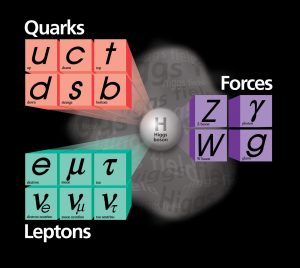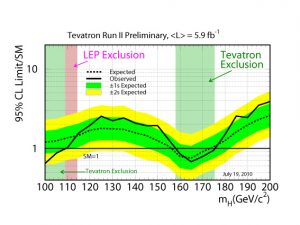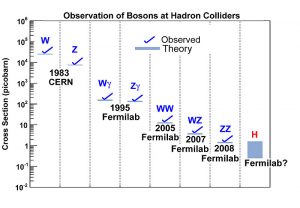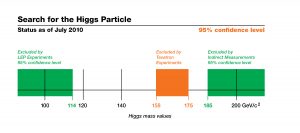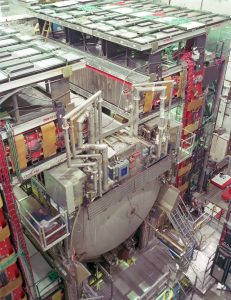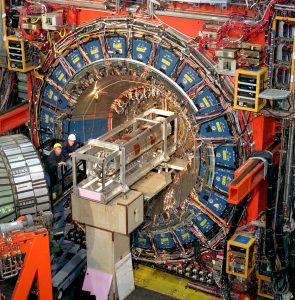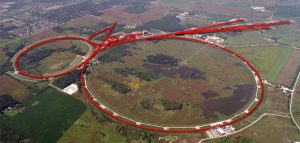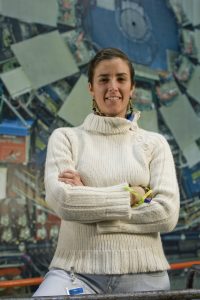Batavia, Ill.—New constraints on the elusive Higgs particle are more stringent than ever before. Scientists of the CDF and DZero collider experiments at the U.S. Department of Energy’s Fermilab revealed their latest Higgs search results today (July 26) at the International Conference on High Energy Physics, held in Paris from July 22-28. Their results rule out a significant fraction of the allowed mass range established by earlier experiments.
The Fermilab experiments now exclude a Higgs particle with a mass between 158 and 175 GeV/c2. Searches by previous experiments and constraints due to the Standard Model of Particles and Forces indicate that the Higgs particle should have a mass between 114 and 185 GeV/c2. (For comparison: 100 GeV/c2 is equivalent to 107 times the mass of a proton.) The new Fermilab result rules out about a quarter of the expected Higgs mass range.
“Fermilab has pushed the productivity of the Tevatron collider to new heights,” said Dennis Kovar, DOE Associate Director of Science for High Energy Physics. “Thanks to the extraordinary performance of Fermilab’s Tevatron collider, CDF and DZero collaborators from around the world are producing exciting results and are making immense progress on the search for the Higgs particle.”
At the ICHEP conference, CDF and DZero scientists are giving more than 40 talks on searches for exotic particles and dark matter candidates, discoveries of new decay channels of known particles and precision measurements of numerous particle properties. Together, the two collaborations present about 150 results.
The Higgs particle is the last not-yet-observed piece of the theoretical framework known as the Standard Model of Particles and Forces. According to the Standard Model, the Higgs boson explains why some particles have mass and others do not.
“We are close to completely ruling out a Higgs boson with a large mass,” said DZero co-spokesperson Dmitri Denisov, one of 500 scientists from 19 countries working on the DZero experiment. “Three years ago, we would not have thought that this would be possible. With more data coming in, our experiments are beginning to be sensitive to a low-mass Higgs boson.”
Robert Roser, co-spokesperson for the 550 physicists from 13 countries of the CDF collaboration, also credited the great work of the CDF and DZero analysis groups for the stringent Higgs exclusion results.
“The new Higgs search results benefited from the wealth of Tevatron collision data and the smart search algorithms developed by lots of bright people, including hundreds of graduate students,” Roser said. “The CDF and DZero analysis groups have gained a better understanding of collisions that can mimic a Higgs signal; improved the sensitivity of their detectors to particle signals; and included new Higgs decay channels in the overall analysis.”
To obtain the latest Higgs search result, the CDF and DZero analysis groups separately sifted through more than 500,000 billion proton-antiproton collisions that the Tevatron has delivered to each experiment since 2001. After the two groups obtained their independent Higgs search results, they combined their results to produce the joint exclusion limits.
“Our latest result is based on about twice as much data as a year and a half ago,” said DZero co-spokesperson Stefan Söldner-Rembold, of the University of Manchester. “As we continue to collect and analyze data, the Tevatron experiments will either exclude the Standard Model Higgs boson in the entire allowed mass range or see first hints of its existence.”
The observation of the Higgs particle is also one of the goals of the Large Hadron Collider experiments at the European laboratory CERN, which record proton-proton collisions that have 3.5 times the energy of Tevatron collisions. But for rare subatomic processes such as the production of a Higgs particle with a low mass, extra energy is less important than a large number of collisions produced.
“With the Tevatron cranking out more and more collisions, we have a good chance of catching a glimpse of the Higgs boson,” said CDF co-spokesperson Giovanni Punzi, of the University of Pisa and the National Institute of Nuclear Physics (INFN) in Italy. “It will be fascinating to see what Mother Nature has in her cards for us. We might find out that the Higgs properties are different from what we expect, revealing new insights into the origin of matter.”
Notes for editors:
Funding for the CDF and DZero experiments comes from DOE’s Office of Science, the National Science Foundation, and numerous international funding agencies.
CDF collaborating institutions are at http://www-cdf.fnal.gov/collaboration/index.html
DZero collaborating institutions are at http://www-d0.fnal.gov/ib/Institutions.html
Fermi National Accelerator Laboratory is a U.S. Department of Energy Office of Science national laboratory dedicated to research in high-energy physics and related fields. The Fermi Research Alliance LLC operates Fermilab under a contract with DOE.
- According to the Standard Model of particles and forces, the Higgs mechanism gives mass to elementary particles such as electrons and quarks. Its discovery would answer one of the big questions in physics: What is the origin of mass?
- Observed and expected exclusion limits for a Standard Model Higgs boson at the 95-percent confidence level for the combined CDF and DZero analyses. The limits are expressed as multiples of the SM prediction for test masses chosen every 5 GeV/c² in the range of 100 to 200 GeV/c². The points are joined by straight lines for better readability. The yellow and green bands indicate the 68- and 95-percent probability regions, in the absence of a signal. The CDF and DZero data exclude a Higgs boson between 158 and 175 GeV/c² at the 95-percent confidence level and show that the Tevatron experiments are beginning to be sensitive to a low-mass Higgs boson.
- In the last 15 years, the CDF and DZero experiments at Fermilab have discovered increasingly rare combinations of the electroweak force carriers — gamma, W and Z — emerging from proton-antiproton collisions at the Tevatron. With the Tevatron producing a record number of particle collisions, the CDF and DZero experiments might be able to catch a glimpse of the Higgs particle. The uncertainty in the predicted cross section for the Higgs boson reflects the range of Higgs masses not yet excluded by experiment.
- Scientists from the CDF and DZero collaborations at DOE’s Fermilab have combined Tevatron data from their two experiments to increase the sensitivity for their search for the Higgs boson. While no Higgs boson has been found yet, the results announced today exclude a mass for the Higgs between 158 and 175 GeV/c² with 95 percent probability. Earlier experiments at the Large Electron-Positron Collider at CERN excluded a Higgs boson with a mass of less than 114 GeV/c² at 95 percent probability. Calculations of quantum effects involving the Higgs boson require its mass to be less than 185 GeV/c². The Fermilab experimenters will test more and more of the available mass range for the Higgs as their experiments record more collision data and as they continue to refine their experimental analyses.
- The DZero detector records particles emerging from high-energy proton-antiproton collisions produced by the Tevatron. Tracing the particles back to the center of the collision, scientists understand the subatomic processes that take place at the core of proton-antiproton collisions. Scientists search for the tiny fraction of collisions that might have produced a Higgs boson.
- The CDF detector, about the size of a 3-story house, weighs about 6,000 tons. Its subsystems record the “debris” emerging from each high-energy proton-antiproton collision produced by the Tevatron. The detector records the path, energy and charge of the particles emerging from the collisions. This information can be used to look for particles emerging from the decay of a short-lived Higgs particle. Med Res | Hi Res The DZero detector records particles emerging from high-energy proton-antiproton collisions produced by the Tevatron. Tracing the particles back to the center of the collision, scientists understand the subatomic processes that take place at the core of proton-antiproton collisions. Scientists search for the tiny fraction of collisions that might have produced a Higgs boson. For additional photos and B roll video footage, including video clips of the Tevatron collider experiments and aerials of the Fermilab site, visit the Fermilab Visual Media Services website. To obtain permission for the use of this additional material, please send an email to vismedsr@fnal.gov.
- The Fermilab accelerator complex accelerates protons and antiprotons close to the speed of light. The Tevatron produces about ten million proton-antiproton collisions per second, maximizing the chance for discovery. Two experiments, CDF and DZero, search for new subatomic particles and forces unveiled by the collisions.
- Listen to DZero physicist Michael Kirby, Northwestern University, as he explains in this 2-minute video how DZero collects and analyses collision data to find signs of the Higgs particle. Kirby is one of about 500 physicists from 80 institutions in 19 countries who work on the DZero experiment at Fermilab.
- Listen to CDF physicist Barbara Alvarez-Gonzalez, formerly a graduate student at the University of Oviedo and now a postdoctoral scientist at Michigan State University, as she explains in this 2-minute video the search for the Higgs particle with the CDF detector. Alvarez-Gonzalez is one of about 600 physicists from 63 institutions in 15 countries who work on the CDF experiment at Fermilab.




